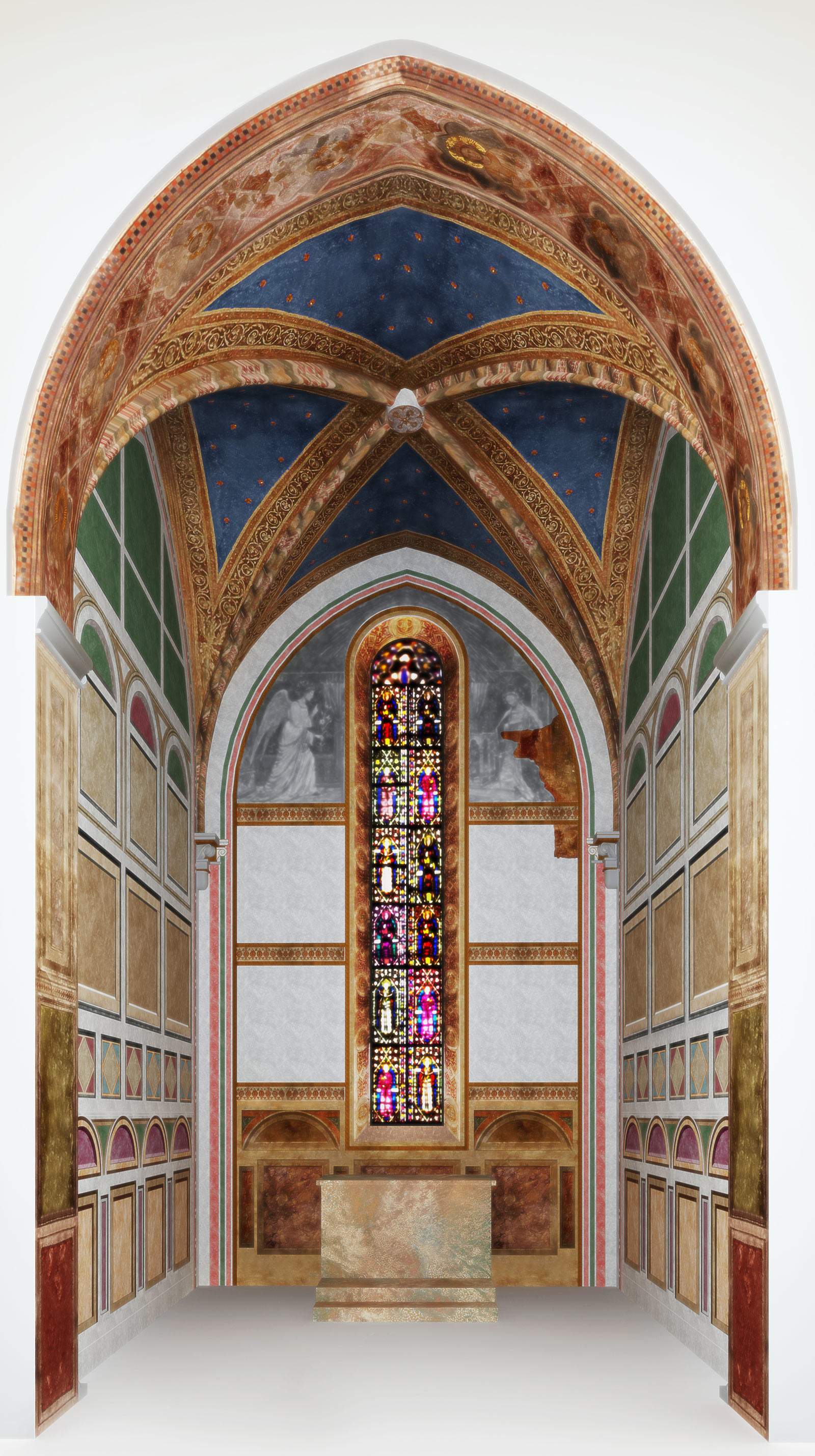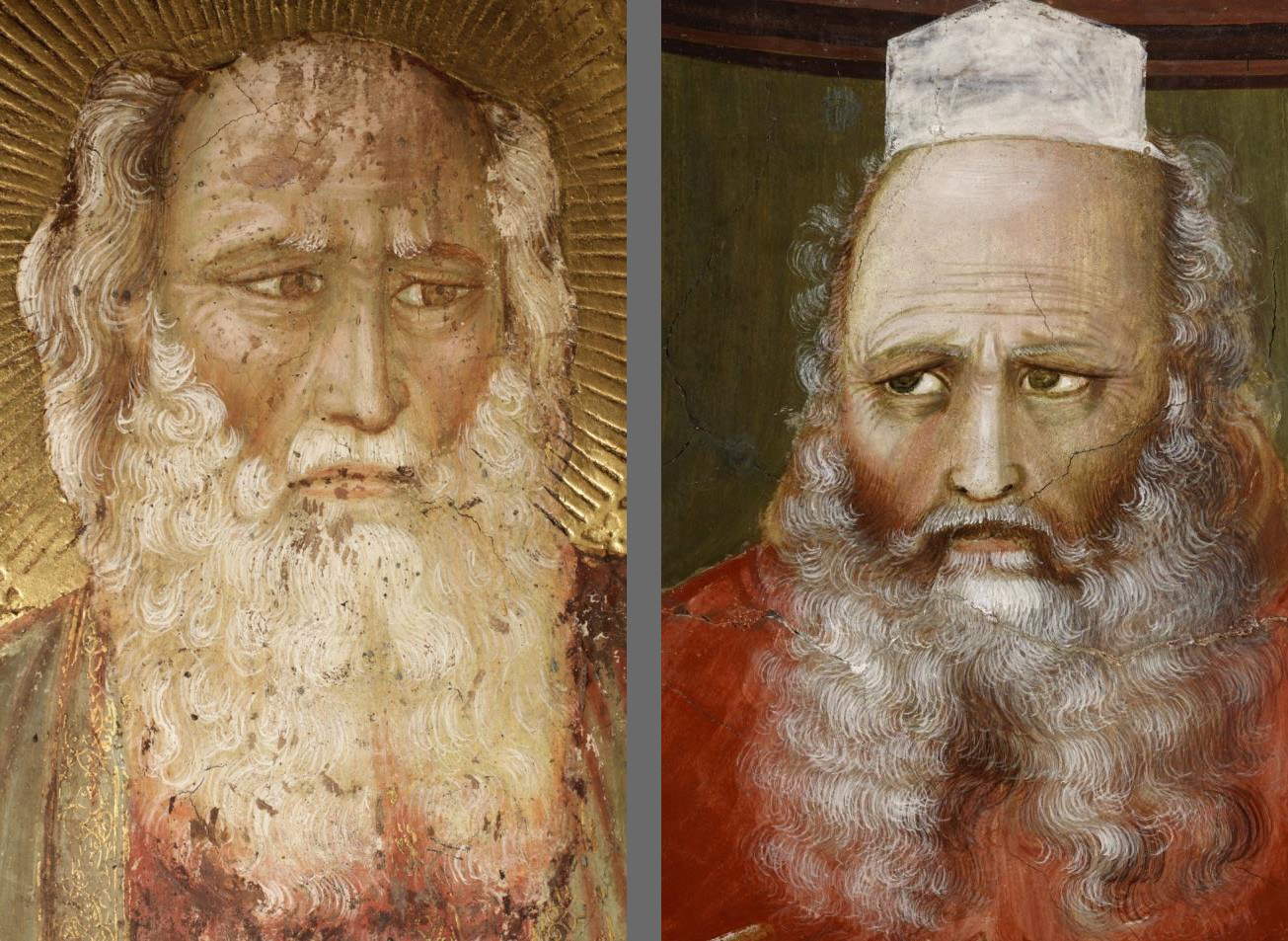Young art historian Giacomo Guazzini, born in 1984, has authored an important discovery regarding Giotto’s (Florence?, c. 1267 - Florence, 1337) activity in Padua, and in particular his presence in the Basilica of St. Anthony. Giotto, in fact, worked in the chapel of St. Catherine inside the Basilica del Santo.Guazzini’s latest research investigated the chapel’s decorations and found that Giotto’s cycle was much larger than previously thought. The work has led to a digital reconstruction that helps us understand more about the original appearance of the cycle. That’snot all: in 2015 Guazzini had identified the Glorification of the Virgin among angels and prophets, in the chapel of the Madonna Mora, as another valuable and unknown evidence of Giotto’s activity in Padua. We talked about all this with Giacomo Guazzini. The interview is by Ilaria Baratta.
 |
| Reconstruction of the cycle in the chapel of Santa Caterina (graphics by Enrico Bancone) |
 |
| Chapel of Saint Catherine, current state (Padua, Basilica del Santo) |
IB. What prompted your research that led to the discovery of a second Scrovegni Chapel right inside the Basilica del Santo in Padua? When did your first studies on the subject date back to?
GG. The work on the Giottesque cycle in the Chapel of St. Catherine in the Basilica of SantAntonio in Padua is the result of research I am carrying out as a postdoctoral researcher at the Kusthistorisches Institut (Max-Planck-Institut) in Florence, to whom my deepest gratitude goes for their support. My studies on Padua began in 2014 with a doctoral dissertation at the Scuola Normale Superiore in Pisa, on the occasion of which I had the opportunity to discover in the chapel of the Madonna Mora in the Basilica an important and completely unknown fresco by Giotto: a large Glorification of the Virgin among prophets and angels (visible behind a sculpture with a later Madonna and Child ), which until then had been considered the work of a follower of Altichiero from the late 14th century. On closer inspection, however, it turned out to be a work of the highest quality, perfectly in line with Giotto’s most beautiful and autograph parts in the Arena Chapel, designed to adorn a particularly important place in the Basilica, namely the first and most venerated tomb of St. Anthony. News of this first discovery was given in the Sole 24 Ore of March 1, 2015, which was shortly followed by the publication of the essay in the scholarly journal Nuovi Studi(A new Giotto at the Saint of Padua: the chapel of the Madonna Mora), an identification that was unanimously confirmed by leading specialists at the international level. Instead, the work that I am now about to publish (in the international journal Mitteilungen des Kunsthistorischen Institutes in Florenz) is the result of further research and in-depth study investigating other Giotto enterprises in the same Basilica. Specifically, I focused on the first chapel of the ambulatory dedicated to St. Catherine, where already many years ago Francesca Flores dArcais had rightly identified fragments of Giotto’s decorations in the entrance sub-arch.
What is the history of the chapel and what were the stages of the discovery?
Although profound 20th-century restorations radically disrupted the chapel’s ancient decorative arrangement, clear traces of Giottesque decorations remain today in the chapel’s entrance subarch: a series of busts of saints within clypeus, already well known to critics. Considering, however, that these fragments must originally have been part of a much more extensive decoration, I therefore sought to investigate further in order to understand the ancient decorative arrangement of this extensive Giottesque enterprise, now lost. The ancient fourteenth-century decoration was basically supposed to remain visible until 1734, when it was completely covered by a whitewash: in that condition it remained until the early twentieth century, when parts of the ancient underlying decorations began to surface and come back to light from the eighteenth-century whitewash. The research was therefore based both on the study of some precious photographs from the period before the restorations, and on the punctual investigation of the two restorations that radically altered this space: the first, which took place between 1923 and 1925, was carried out by Giuseppe Cherubini (in charge of removing the whitewash and restoring the ancient decorations that had surfaced), and the second, between 1981 and 1983, was carried out by Pietro Annigoni, who was commissioned to entirely cover the side walls with new curtain walls and frescoes with Stories of Saint Anthony. The analysis of the photographs and the study of the restorations was followed by a careful reconnaissance of the current state, and then by a campaign of punctual metric surveys and digital reconstructions of the original decorative tapestry, carried out thanks to the invaluable collaboration and expertise of graphic designer Enrico Bancone. From the period photographs prior to the twentieth-century restorations (and the resulting digital reconstruction), a complex decoration clearly emerges on the side walls, largely devoid of figures, consisting of a series of overlapping registers of faux architecture with perspective illusionism: marble slabs, recessed aedicules, lunettes, pilasters and cornices. A kind of continuous architectural trompe-loeil, illusionistically conceived in function of the observer located at the entrance to the Chapel.
What is Giotto’s relationship with his patrons? Are there documents that clarify these relationships that resulted in the Paduan projects?
From the investigation of the photographs, in addition to the conformation of this lost Giotto cycle, another, very important novelty has emerged, namely the sure identification of the patronage of the chapel: the famous Scrovegni family. It must have been Enrico himself, responsible for the famous Arena chapel, who commissioned this decoration, as evidenced by the discovery of the family coat of arms in the entrance sub-archway: a blue sow on an ochre background, visible in period photos, still present today. This complex decoration must likely have preceded the great cycle at the Arena (1303-1305): Giotto in those years was by then a celebrated artist in great demand throughout Italy, but Enrico Scrovegni probably wanted to entrust him with the decoration of the family chapel to the Saint (the city sanctuary and public stage par excellence) perhaps also as a kind of rehearsal in view of the grandiose undertaking for the private loratorio.
 |
| The Scrovegni coat of arms |
 |
| Giotto, Glorification of the Virgin (c. 1300-1303; Padua, Basilica del Santo, chapel of the Madonna Mora) |
 |
| Left: Giotto, Glorification of the Virgin, detail of the prophet Isaiah. Right: Giotto, Prayer of the Rods, detail (1303-1305; Padua, Scrovegni Chapel allArena) |
How does our knowledge of Giotto change as a result of his studies?
The Catherini cycle, characterized by a complex and dynamic system of subtle spatial modulations, is the result of a major artistic and conceptual renewal by Giotto, implemented through the adoption of a language inspired by ancient Roman art, by which he was deeply impressed and fascinated during his very recent stay in Rome around the year 1300. This recovered enterprise appears as a true link between Giotto’s earliest and most heroic phase in the Stories of St. Francis in Assisi (c. 1290-1292), and the later, more classical phase of the Arena cycle (1303-1305), characterized by a new and subtle attention to the illusionistic modulation of space and subject matter through painting, inaugurating a new dialogue between illusion and reality,as perfectly exemplified at theArena by the incredible fake choruses or the fake aedicules embedded with personifications of Vices and Virtues in the lower part of the walls. Giotto elaborates here a true experimental worksite, where he fine-tunes a number of fundamental ideas and aspects that will be further developed and perfected in the later undertaking of the Arena. With this first chapel for the Scrovegni we thus have a new and important piece to better understand the path of the artist who more than any other revolutionized and thoroughly reshaped Italian art, through the search for a new and dynamic relationship between real architecture, painting and the observer, thus determining the birth of a new and modern painting.
To conclude, what are your future plans?
Obviously I plan to continue this research on Giotto, but unfortunately my position is on a deadline: although the focus of our work is Italy, enhancing its linesauribile artistic and cultural heritage, in Italy it is almost impossible to pursue research at the university level due to the complete lack of economic support and work positions. I am extremely grateful towards the German Institute of Art History for which I work, a foreign research institute that invests heavily in research in our territory and our heritage: it is shameful that at the national level research is left to die in this way. Lun’s only prospect, like all those of our generation, is to pack our bags and find a place abroad (on all the United States and the United Kingdom), in order to carry on our work.
Warning: the translation into English of the original Italian article was created using automatic tools. We undertake to review all articles, but we do not guarantee the total absence of inaccuracies in the translation due to the program. You can find the original by clicking on the ITA button. If you find any mistake,please contact us.